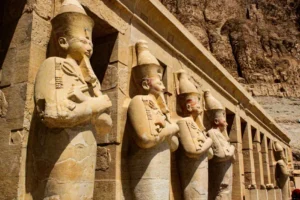The Temple of Queen Hatshepsut stands as an enduring testament to the grandeur and ingenuity of ancient Egypt. Nestled in the cliffs of Deir el-Bahri, near Luxor, this architectural marvel is not merely a tomb but a celebration of one of history’s most remarkable rulers. Hatshepsut, a queen who defied tradition to rule as pharaoh, left behind a legacy of prosperity and monumental achievements. Her temple, with its terraced design and intricate reliefs, captures her ambitious reign and visionary leadership. Visitors are captivated not only by the temple’s grandeur but also by the compelling story of a woman who reshaped the perception of power in ancient Egypt.
A Visionary Structure Among the Cliffs
The Mortuary Temple of Queen Hatshepsut is renowned for its innovative design. Built into the limestone cliffs, the temple features three grand terraces connected by elegant ramps. Each level showcases intricately carved reliefs that narrate key events from Hatshepsut’s reign, such as her divine birth and trade expeditions to Punt. These carvings reflect her desire to legitimize her rule and emphasize her divine right to govern.
The temple’s alignment with the winter solstice further reveals the sophistication of ancient Egyptian astronomy. On this day, sunlight illuminates the inner sanctum, signifying Hatshepsut’s connection to the gods. This celestial alignment underscores the meticulous planning that defined Egyptian temple construction.
Adding to its uniqueness, the temple’s architecture blends seamlessly with the surrounding cliffs, symbolizing harmony between human endeavor and nature. It’s a masterpiece that continues to inspire awe and admiration.
The Queen Who Changed History
Hatshepsut’s ascent to power was unprecedented. Born to Thutmose I and Queen Ahmose, she initially held the title of Great Royal Wife as the spouse of her half-brother, Thutmose II. Her rise began after his death, when she served as regent for the young Thutmose III. However, she soon proclaimed herself pharaoh, adopting male regalia, including a false beard and the traditional kilt.
Why did Hatshepsut dress like a man? Ancient Egyptian society was deeply patriarchal, and male imagery reinforced her authority as a ruler. Despite these challenges, Hatshepsut’s reign was marked by economic growth, monumental architecture, and artistic innovation. She also emphasized her divine lineage, referring to herself as “Maatkare,” meaning “Truth is the soul of Ra.” This title reflected her devotion to the god Amun and her role as a bringer of cosmic order.

famous egyptian queen
The Legacy of Hatshepsut’s Reign
Hatshepsut’s policies and projects greatly benefited her people. She commissioned the construction of temples, obelisks, and other monuments, creating employment opportunities and showcasing Egypt’s wealth. One of her most celebrated achievements was the expedition to Punt, which brought back valuable goods like incense, ebony, and myrrh. These trade missions boosted Egypt’s economy and solidified its status as a powerful nation.
But what happened to Hatshepsut’s daughter, Neferure? Historical records suggest she played a significant role in her mother’s administration, possibly serving as a high priestess of Amun. However, Neferure’s fate remains a mystery, as she disappears from historical accounts after her adolescence.
Hatshepsut’s reign lasted over two decades, a period of stability and prosperity. Despite her achievements, her successor, Thutmose III, sought to erase her legacy, removing her name and images from monuments. This deliberate act raises the question: Which Egyptian queen was removed from history? Hatshepsut’s erasure underscores the challenges she faced as a female ruler in a male-dominated society.
The Enigma of Hatshepsut’s Burial
Her mummy was discovered in the Valley of the Kings, specifically in tomb KV60. Initially unrecognized, her remains were identified in 2007 through DNA analysis and a missing tooth found in a relic box inscribed with her name. This discovery shed light on her physical appearance, answering the question: What did Hatshepsut look like? Evidence suggests she was a stout woman, possibly suffering from diabetes and other health issues.
Hatshepsut’s burial in the Valley of the Kings highlights a shift in Egyptian funerary practices. Earlier pharaohs were buried in pyramids, but concerns about tomb security led to the construction of hidden tombs in the valley. This change prompts another intriguing inquiry: Why did the Egyptians turn away from building pyramids? The rise of tomb robbers made concealed burial sites a necessity.

Fun Facts and Lasting Mysteries
While her reign was largely peaceful, inscriptions suggest she maintained a strong military presence to protect Egypt’s borders. Her ability to balance diplomacy with defense underscores her effectiveness as a leader. Was Hatshepsut a good leader? The prosperity and stability of her reign offer a resounding yes.
How long did Hatshepsut live? She likely died in her fifties, a respectable age for the time. Her reign of approximately 22 years left an indelible mark on Egypt’s history. What are three fun facts about Hatshepsut? First, she introduced the first recorded zoo in history, importing exotic animals from Punt. Second, she pioneered trade routes that enriched Egypt. Third, her obelisks remain among the tallest ever erected.
The Temple of Queen Hatshepsut and her enduring legacy continue to captivate historians and visitors alike. This iconic site not only celebrates a powerful queen but also serves as a window into the brilliance of ancient Egyptian civilization.








